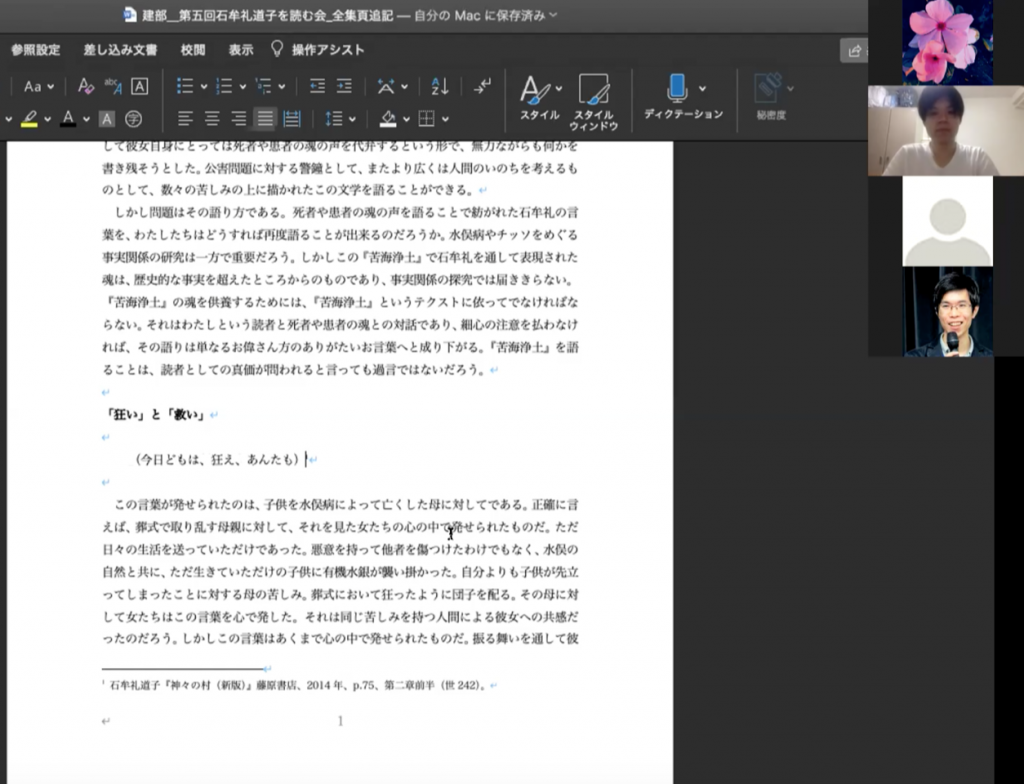The fifth Ishimure Michiko Reading Group was held via Zoom on August 17, 2020 at 3:00 p.m. Tsuyoshi Ishii (The University of Tokyo), Masahisa Suzuki (The University of Tokyo), Shiho Maeshima (The University of Tokyo), Ching-yuen Cheung (The University of Tokyo), Maki Sato (The University of Tokyo), Mizuki Uno (The University of Tokyo), Hanako Takayama (The University of Tokyo), Akihiro Miyata (The University of Tokyo), Yudai Tanaka (The University of Tokyo), and Ryohei Tatebe (The University of Tokyo) participated in this session We continued our reading of the second part of Kugai Jodo, and Ryohei Tatebe gave a report. The supplementary articles for this session are listed below.
・渡辺京二「解説 『苦海浄土』三部作で要の位置を占める作品」、『新版:神々の村』藤原書店、2014年、pp.395-404。
・「絶対負荷をになうひとびとに」、『石牟礼道子全集』第三巻、藤原書店、2004年、pp.431-444。
・「『苦海浄土』来し方行く末(上野英信との対談)」、同上、pp.511-531。
・「玄郷の世界(中村了権との対談)」、同上、pp.559-570。
Ryohei reconsidered how kurui and sukui are important in the text of Kamigami-no-mura. In the last chapter, Chapter Six, there is a remarkable scene depicting a general meeting of the Chisso corporation. Here, the Minamata patients and supporters come together as one to brace the president of Chisso on the stage where he is speaking. Ryohei wondered if this type of situation where people join together in their anger could be viewed as a type of sukui in the inner mind, something that could be considered in light of the description of the patients confessing the day after the general meeting that they had tried their best to channel their anger. Ryohei pointed out that he felt this was refreshing for the patients, and he also noted that the voice, “You too, get angry today”, was only said in the mother’s mind. He introduced a dialogue between Ishimure and Eishin Ueno in which Ishimure said that the annual meeting was a kind of hare. From this idea, Ryohei considered the significance of the song that followed, which enables this kind of collective kurui and sukui.

Before confronting the president, the Minamata patients sang Goeika, beginning with hitono-kono-yo-ha-nagakushite… which they practiced for this occasion. Their initial practice did not go very well, but the power of melody and lyrics, the voice coming from deep within their bodies, and the Miyako building as the place where the general meeting was held combined to create a strong effect when they sang it later. This fusion of elements forms the basis for Ryohei’s ideas about the several descriptions of the song in this second part. Of course, this action did not result in those suffering from Minamata disease being cured, nor did it present solutions to all the problems they faced. Furthermore, there was no real apology from Chisso itself. Ryohei speculated that the sukui in this text would be minimal, considering how little hope there was.
The discussion was very active. We talked about the aspect of play in the scene depicting the general meeting and the people’s playful behavior. The distance between the patients and Ishimure, as well as that between Ishimure and us were also noted. We then asked what is the meaning of the writing of Kugai Jodo, Paradise in the Sea of Sorrow, itself?
In the end, what we confirmed is that discussion of Kugai Jodo is very difficult. Ishimure’s way of writing is not only sensitive, but also particular. How can we rephrase her words today? This is a challenge that we would try to meet.
Reported by Ryohei Tatebe (EAA Research Assistant)
Translated by Hanako Takayama (EAA Project Assistant Professor)








